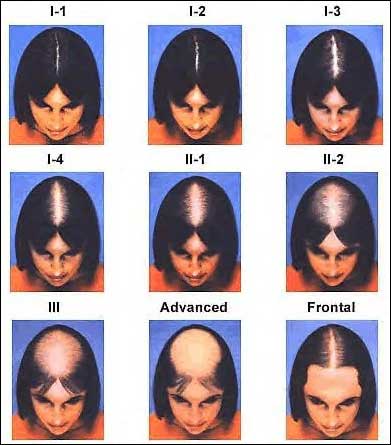The Savin Scale: What Is It and Why Does It Matter?
Diagnosing the cause of hair loss and understanding the degree of it are related and often linked tasks. Their core questions, however, are different, and so too are the tools used to reach answers. Diagnosis asks ‘Why is there hair loss?’ and utilizes a number of methods to find the cause, while labeling the degree of loss asks ‘How bad is the hair loss?’ and uses an objective visual scale to appropriately gauge the current state of follicles on the scalp. The Savin Scale is one of these scales; it is a tool used specifically for measuring the degree of hair loss in women.
Though four main scales have been suggested by doctors for measuring the level of female hair loss, the Savin Scale is the most widely used. Very similar to the Ludwig Scale, it was developed, tested, and put forth by Dr. Ronald Savin in the mid 1990s as a way to better facilitate hair loss research. Where the Savin Scale differs from the Ludwig Scale is in its ability to measure overall thinning in addition to loss. As can be seen in the image below, female pattern hair loss occurs along the part, and the Savin Scale acknowledges 3 different stages (I, II, and III) detailed as 9 unique phases (I-1, I-2, I-3, I-4, II-1, II-2, III, advanced, and frontal). When a hair restoration specialist or doctor sees a female patient, they examine her head, hair, and scalp and compare it to the scale. By choosing the image that most closely resembles the patient’s patterns, the specialist can gain a more measurable and communicable understanding of the degree of the woman’s hair loss.
So why is a scale like this so important? For a number of reasons! First, it can be difficult for researchers to discuss and compare their findings when there is not a shared method for recording various degrees of hair loss. With widespread acceptance and use of the Savin Scale, these researchers are now able to operate with a higher level of assurance that their understanding of a specified degree of female hair loss is the same as that of their peers. An invented and over-simplified example is that rather than two researchers comparing notes in which one of their studies discusses “early stage” hair loss and another reviews “light” hair loss (terms that they each defined separately and perhaps differently), they can now label the degree in question using the Savin Scale, knowing that when a reference is made to stage I-3, it is done with confidence that they are in agreement about exactly what that means.
Second, getting on the same page about more clearly defined stages of hair loss also has implications for doctors and restoration specialists as they ask questions and learn new findings. Being able to discuss a specific case with a peer for insight or to elicit a professional opinion is an important part of accuracy and development in the medical field, and the Savin Scale promotes higher levels of understanding in these types of situations too.
Third, and most directly related to the patient, the Savin Scale can be applied to an individual female’s hair loss at various intervals to more accurately gauge the change in her unique hair loss over time. This insight can aid in the diagnostic process, inspire a sense of urgency when necessary, and provide guidance for the best restoration solutions available for each specific woman.



